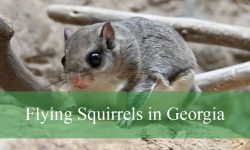Birds with red heads are among the most striking and easily recognizable species in North America. From woodpeckers to finches, many bird species display vibrant red plumage on their heads, making them stand out in forests, grasslands, and even suburban backyards. These birds with red heads often use their bold coloration for mating displays or as a form of species recognition. Some of the most common red-headed birds in the United States include the Red-headed Woodpecker, House Finch, and Northern Cardinal, all of which can be found across various habitats, from woodlands to open fields.
Whether you are an avid birdwatcher or simply enjoy spotting colorful birds, identifying a bird with a red head can be an exciting experience. Many of these species are widespread throughout the U.S., thriving in different environments ranging from dense forests to urban parks.
This guide explores 43 fascinating birds with red heads, offering pictures and key identification details to help you recognize them in the wild.
Different Types of Birds with Red Heads
Western Tanager
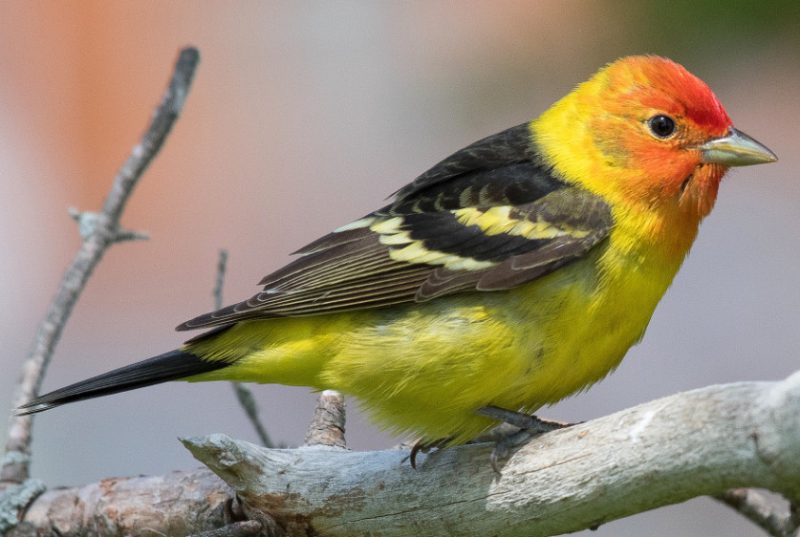
The Western Tanager (Piranga ludoviciana) is a colorful bird with striking differences between males and females. Males have a vivid red head, contrasting with their bright yellow chest, belly, and neck. Their wings are a mix of black and yellow, creating a distinctive appearance. Females, in contrast, are more subdued in color, often displaying brown, chestnut, or gray plumage. This species thrives in mixed and coniferous woodlands, particularly at higher elevations across North America, with a range extending almost to Alaska.
During spring, Western Tanagers migrate to their breeding grounds in the western United States, Canada, and Mexico. They are most commonly seen in forests and wooded areas, where they forage for insects and berries. Their ability to survive for several years and adapt to different habitats makes them a resilient species. Their bright colors and melodic song make them a favorite among birdwatchers.
Redhead
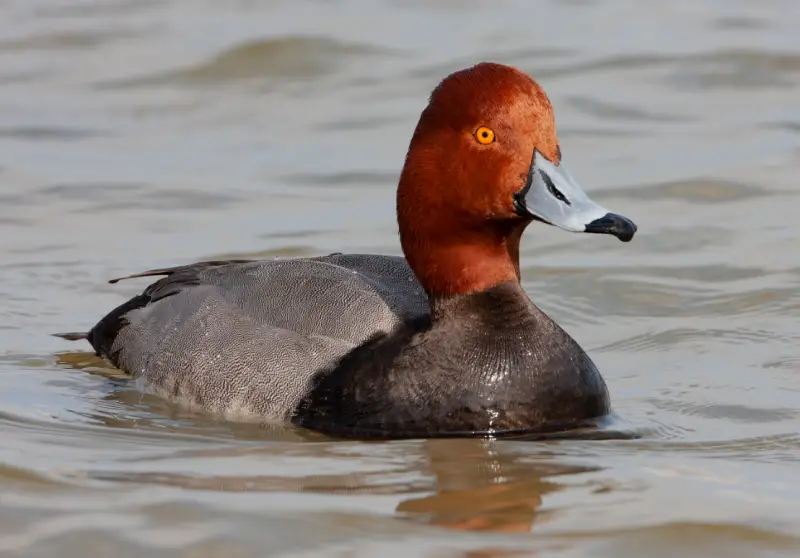
The Redhead (Aythya americana) is a diving duck named for the deep reddish-brown head of its males. This rich copper-like hue plays a role in attracting mates, as males that do not breed tend to develop brown heads similar to females. Females have a more muted appearance, with a brown upper head and a yellowish face. Juveniles also share this brown and yellow coloration. Their body is mostly gray, with a black-tipped blue bill that helps differentiate them from other waterfowl.
Redheads are highly adapted to aquatic life, spending much of their time on lakes, marshes, and ponds. They are excellent divers, using their webbed feet to propel themselves underwater in search of food. However, they are less adept at walking on land due to their short legs. These ducks migrate in spring and fall, with many traveling south to Mexico and the southern United States during winter. Their population is widely distributed across North America, particularly in wetland areas where they can find ample food and shelter.
Scarlet Tanager
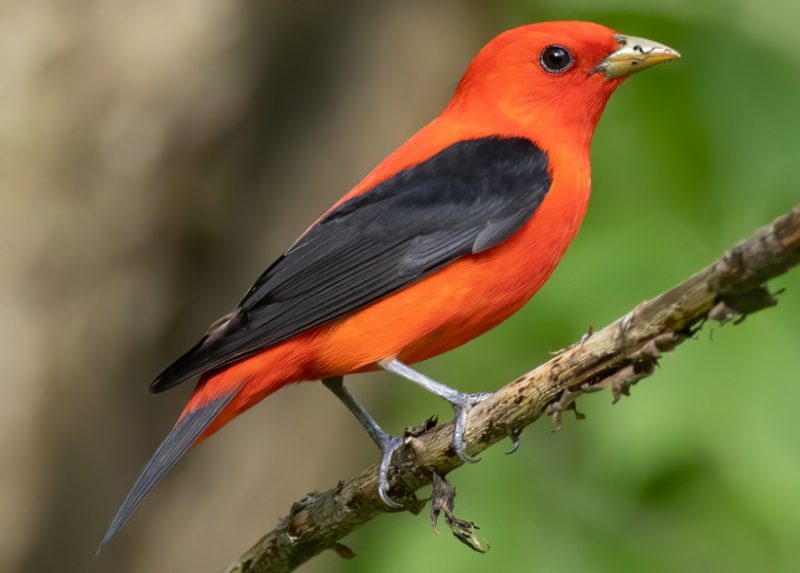
The Scarlet Tanager (Piranga olivacea) is one of the most striking red birds in North America. Males are almost entirely red, with black wings and tails that create a bold contrast. In contrast, females have olive-colored bodies with darker olive wings. Their beaks are short and slightly curved, making them well-suited for catching insects. These birds are primarily found in woodlands, particularly mixed and oak forests, where they blend into the dense foliage.
Scarlet Tanagers have a varied diet that includes insects, worms, spiders, and beetles, which they hunt among the trees. When insect populations are scarce, they supplement their diet with small fruits. Their migratory pattern takes them from their breeding grounds in eastern Canada and the United States to wintering areas in Central and South America, including Colombia, Panama, and Venezuela. Their secretive nature makes them challenging to spot, but their vibrant color and distinct song help bird enthusiasts identify them in the wild.
Red-breasted Sapsucker
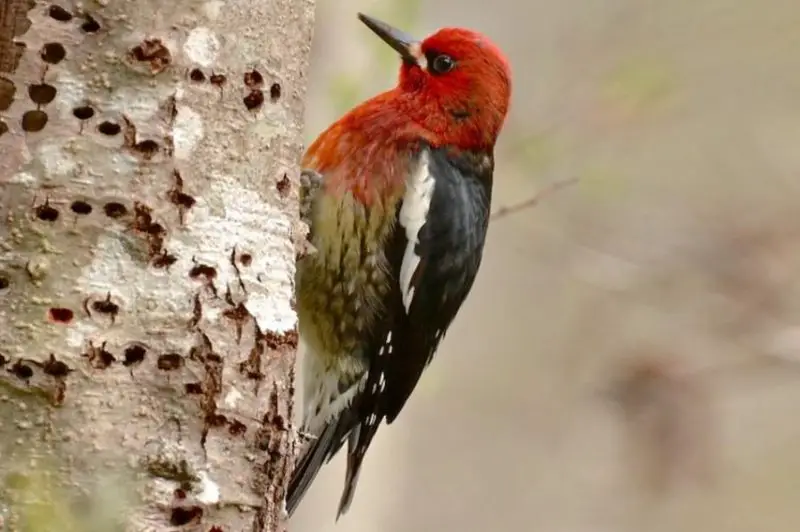
The Red-breasted Sapsucker (Sphyrapicus ruber) is a type of woodpecker named for the red coloring on its upper chest and head. Its body is a mix of gray, black, and white, with distinctive patterns on its back and wings. Both males and females share similar appearances, with young birds being the only ones that lack the characteristic red hues. Unlike many other birds, Red-breasted Sapsuckers are highly cooperative parents, with both sexes taking part in nest-building and chick-rearing.
These woodpeckers inhabit the forests of western North America, from the Rocky Mountains to Alaska and the southwestern United States. They are known for drilling holes in tree bark to access sap, which they consume along with insects attracted to the sap. Two subspecies exist, with one residing in northern regions up to Alaska and the other in the southwestern U.S. These birds are rarely found outside their native woodland habitats, making them a unique sight for birdwatchers exploring their range.
Red-crested Cardinal
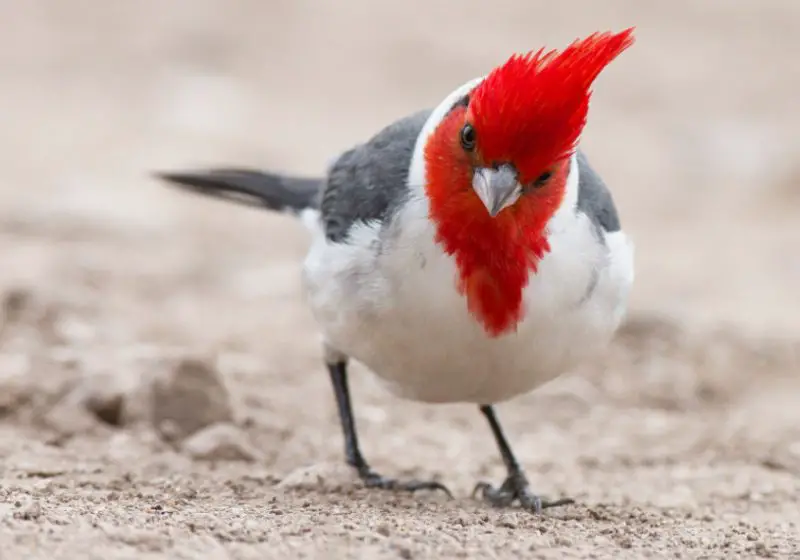
The Red-crested Cardinal (Paroaria coronata) is a striking bird known for its vivid red head and tall red crest, which give it a regal appearance. Its chest and belly are bright white, while its wings are gray, sometimes featuring white markings. Females share the same pattern but with different coloration, having a yellow head and crest along with a white-yellow chest and belly. Their wings are dark gray to black, creating a subtle contrast.
Native to South America, this species is commonly found in Argentina, Brazil, and Uruguay. It has also been introduced successfully to Hawaii and parts of Chile. Red-crested Cardinals prefer lowland woodlands and shrublands, often seen in pairs or small groups. They feed primarily on seeds and insects, adapting well to both natural and urban environments. Their adaptability, striking appearance, and melodious calls make them a favorite among bird enthusiasts worldwide.
Pine Grosbeak
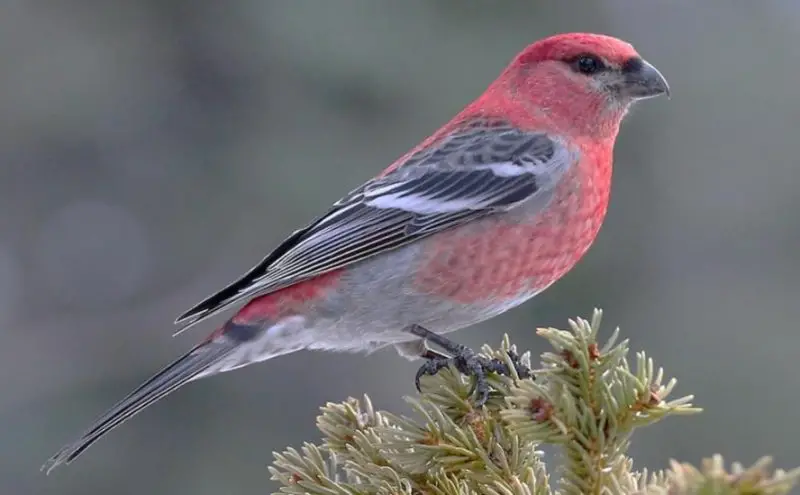
The Pine Grosbeak (Pinicola enucleator) is a striking bird with a vivid red head, chest, and belly in males. Only the lower part of their belly is gray, while their back and wings display a mix of black, white, and red. In contrast, females have yellow or olive-colored heads with gray bodies and black wings, making them look entirely different from the males. Juveniles share a similar appearance to females, further distinguishing them from the bright red males.
These birds primarily inhabit northern forests, thriving in regions across Canada, the United States, and parts of Scandinavia and Russia. They are known for their love of forest fruits, which can lead them to migrate long distances in search of food. Some years, they may leave an area entirely, depending on fruit availability. Despite their occasional migrations, Pine Grosbeaks are generally calm birds that prefer forested environments, where they can be seen perching in treetops or foraging on the ground.
Hepatic Tanager
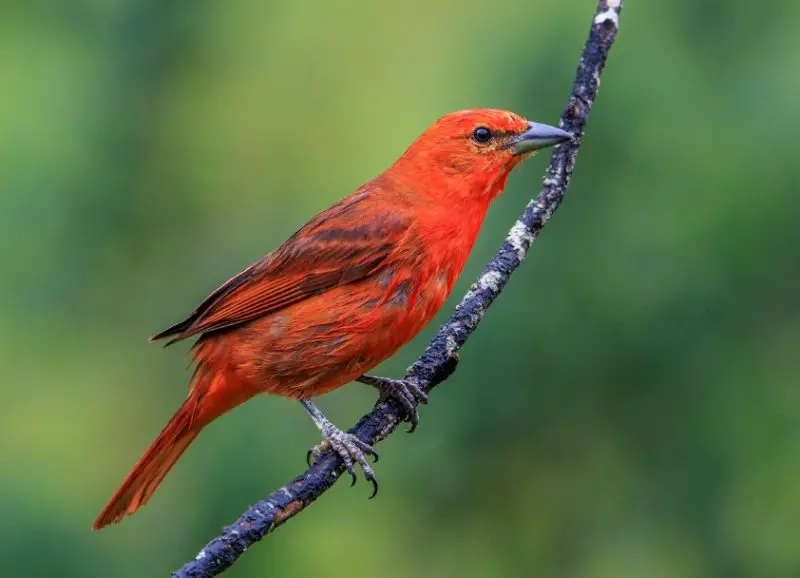
The Hepatic Tanager (Piranga flava) exhibits striking color differences between males and females. Males have a bright red or sometimes pinkish-red head, body, and belly, creating a vivid appearance. Females, on the other hand, are either yellow or golden, lacking the red head seen in males. This color variation makes them easily distinguishable in the wild.
These birds are found across parts of the southwestern United States, Mexico, and South America, including Brazil, Argentina, and Uruguay. Their diet is diverse and varies by location and season. While they primarily consume insects, some populations in Central America have been observed drinking plant nectar during the summer. They also feed on fruits and seeds, adapting to their surroundings for sustenance. Hepatic Tanagers prefer wooded areas, where they can be spotted high in the trees, singing their melodious calls.
ʻIʻiwi
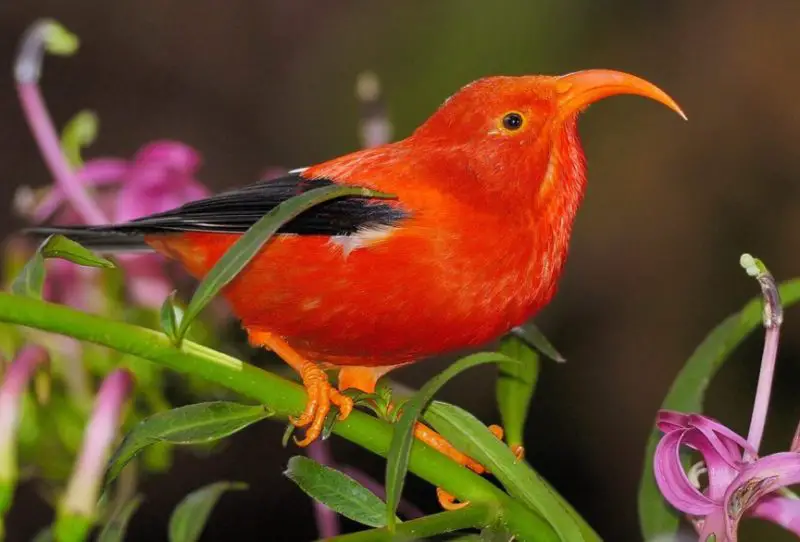
The ʻIʻiwi (Drepanis coccinea) is one of Hawaii’s most recognizable birds, famous for its striking scarlet-red plumage. Its head, back, and belly are covered in this brilliant color, while its wings are black. One of its most distinctive features is its curved beak, which has a pale salmon hue. This specialized beak allows the ʻIʻiwi to feed on nectar from native Hawaiian flowers.
Historically, the feathers of the ʻIʻiwi were used in traditional Hawaiian rituals and for crafting ceremonial garments. These birds primarily reside on Hawaii’s main islands, including Maui, and they move between elevations depending on food availability. Unlike many other birds, they engage in short-range migrations within mountainous regions rather than long-distance migrations. Their dependence on native plants makes them vulnerable to habitat loss, but they remain a symbol of Hawaii’s unique biodiversity.
Northern Red Bishop
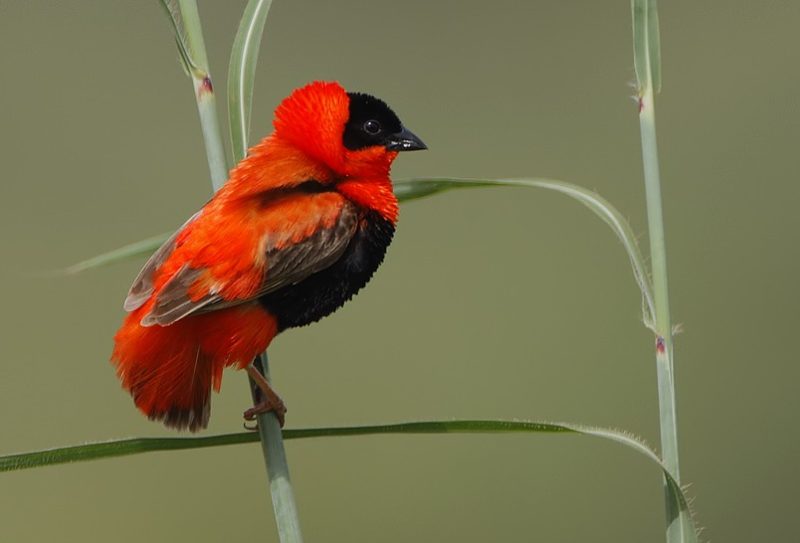
The Northern Red Bishop (Euplectes franciscanus) is a striking bird with a combination of red and black or orange and black plumage. Only the males display red coloration, and this vivid transformation occurs mainly during the breeding season. Their red extends across the back of the head and upper chest, while the front of the head and belly remain black. Their wings often show a mix of red or orange, adding to their vibrant appearance.
Originally from Africa, this species has been introduced to parts of North and Central America, including California and Texas. They are commonly found in grasslands and wetland areas, where they feed on seeds and insects. Northern Red Bishops are known for their elaborate courtship displays, where males puff up their feathers and perform flight displays to attract females. Their adaptability has allowed them to establish stable populations outside their native range.
Flame-colored Tanager
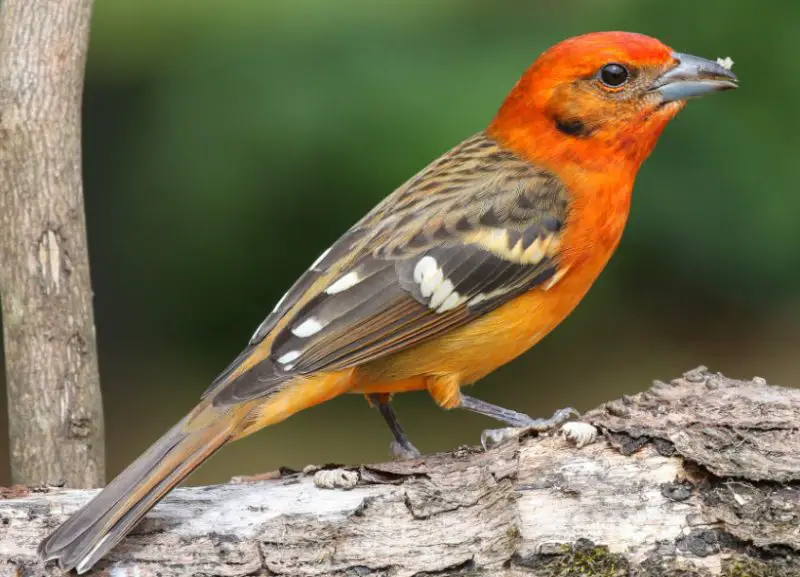
The Flame-colored Tanager (Piranga bidentata) is another brilliantly colored bird, with males displaying a bright red head, back, and belly. Their black wings contrast sharply with their fiery plumage, making them one of the most visually striking birds in their habitat. Females, however, have an entirely different coloration, featuring olive or yellow-olive tones with darker olive or gray wings.
Native to Mexico and parts of Central America, this species is occasionally spotted along the southern U.S. border. They prefer wooded habitats, where they often move in small flocks. Their diet consists of spiders, insects, and other small invertebrates. During the breeding season, both males and females take part in constructing a delicate nest lined with grasses. Though they are not commonly seen in the U.S., their bright colors and unique appearance make them a favorite among birdwatchers when spotted.
Red Avadavat
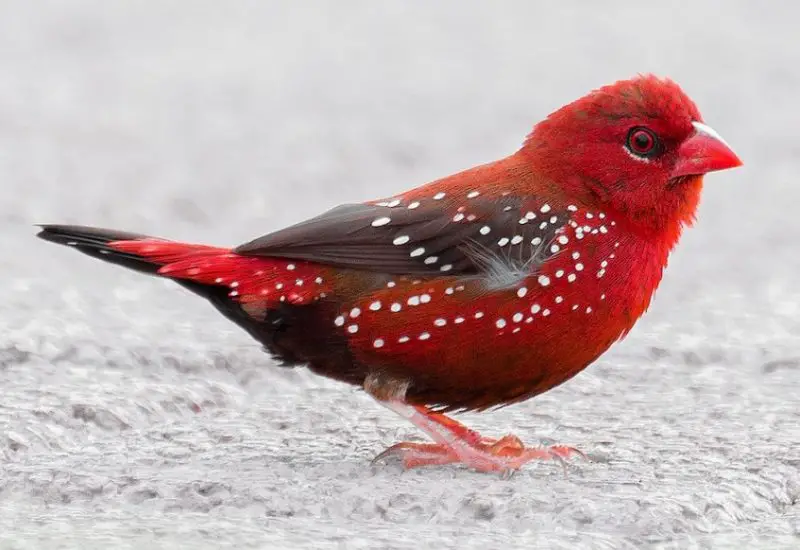
The Red Avadavat (Amandava amandava), also known as the Strawberry Finch, is a small bird with striking red plumage during the breeding season. Only males develop a red head, back, and belly during this period, while their wings remain black with white spots. Outside of the breeding season, males revert to an olive-gray head and back, with yellow bellies.
Females, on the other hand, have a more subdued coloration, featuring yellow and gray tones. Both males and females share a distinctive bright red beak, making them easy to recognize.
Native to the Indian subcontinent, including India, Pakistan, and Nepal, the Red Avadavat thrives in grasslands, wetlands, and agricultural fields. They are often seen in flocks, foraging for seeds and insects. Their vibrant breeding colors and social nature make them a favorite among bird enthusiasts.
White-winged Crossbill
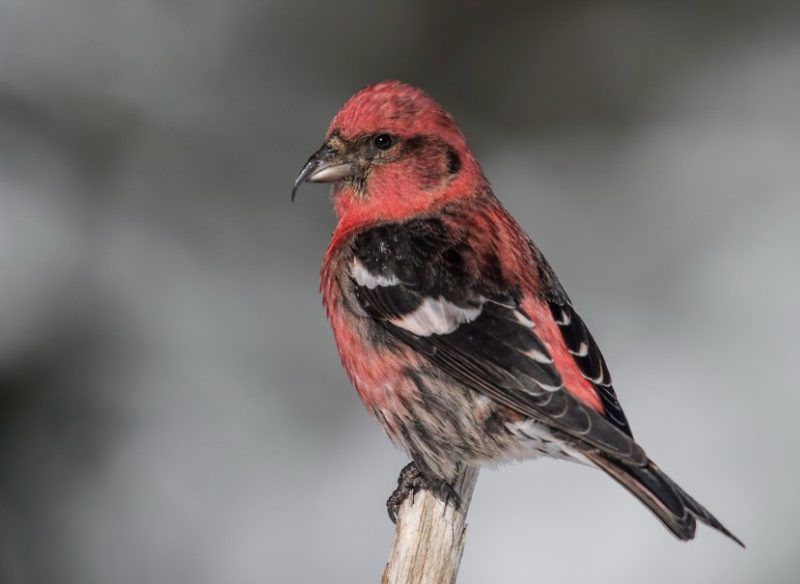
The White-winged Crossbill (Loxia leucoptera) is a fascinating species adapted to northern forests. Males of this species have a red head and body, contrasted by black wings with distinctive white markings. Around their eyes, they have black feathering, adding to their striking appearance.
Females have a completely different color palette, with a yellow head and grayish body, lacking any red plumage. This color differentiation helps in identifying the sexes in the wild.
Found in high-altitude coniferous forests of North America, Europe, and Asia, the White-winged Crossbill has a uniquely adapted beak that allows it to pry open conifer cones to extract seeds. These birds are highly nomadic, moving in response to food availability. Their distribution spans across Alaska, Canada, Russia, China, and Finland, where they are most often spotted in spruce and pine forests.
Yellow-billed Cardinal
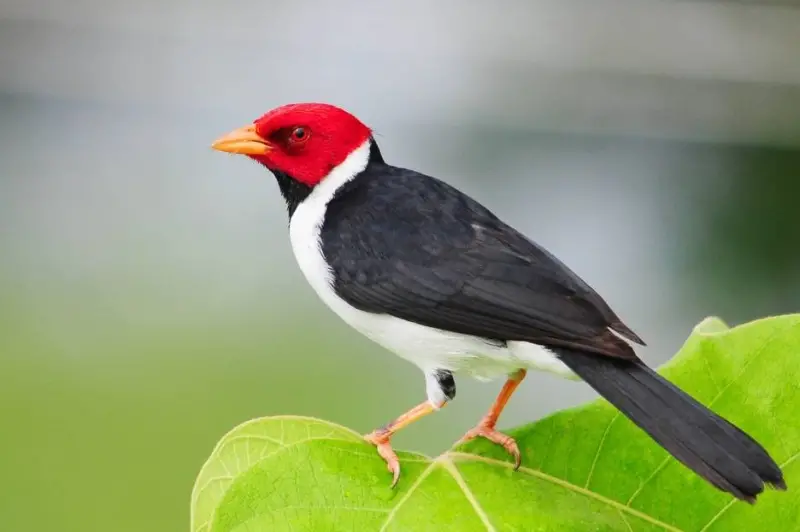
The Yellow-billed Cardinal (Paroaria capitata) is a striking species native to the moist woodlands and shrublands of South America. As its name suggests, one of its defining features is its bright yellow or yellow-orange beak, which is present in both males and females.
Males have a bold red head, a white neck band, and a contrasting white belly. Their back and wings are predominantly black, creating a strong visual contrast. Females have a similar pattern but replace the red head with a yellow or dark yellow shade.
These birds prefer habitats near water, such as marshes, rivers, and lakes. While they are primarily found in Brazil, Uruguay, and Paraguay, they have also been introduced to Hawaii, where they have established stable populations.
Cassin’s Finch
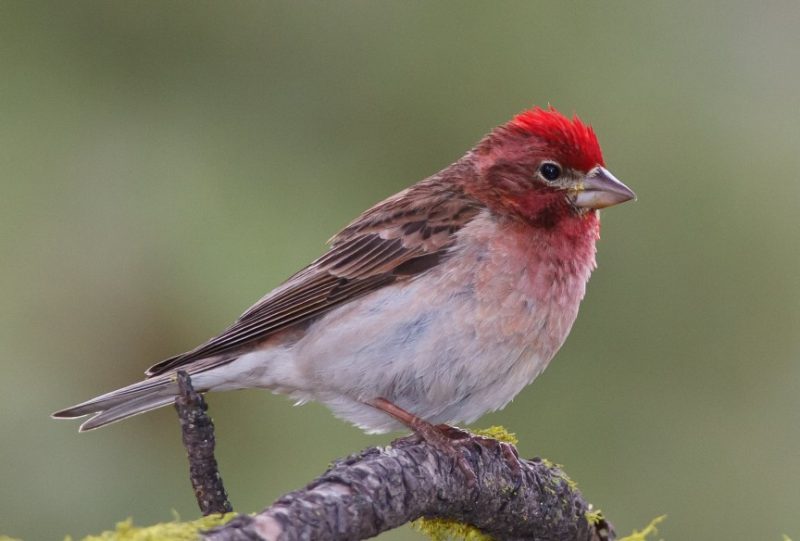
Cassin’s Finch (Haemorhous cassinii) is a small songbird with a distinct red head and red shoulders in males. Their bodies and wings are mostly brown, blending with their woodland habitats. Females lack the red coloration and instead have a brown and gray plumage, making them less conspicuous.
These birds are commonly found in the western United States, Baja California, and parts of Mexico. Migration habits vary depending on location—some populations in the U.S. migrate seasonally, while those in central and lower Mexican regions tend to stay in one place year-round.
Cassin’s Finches primarily feed on seeds and grasses, often foraging in open woodlands and grasslands. Their adaptability allows them to thrive in different environments, though their populations are subject to fluctuations based on food availability.
Purple Finch
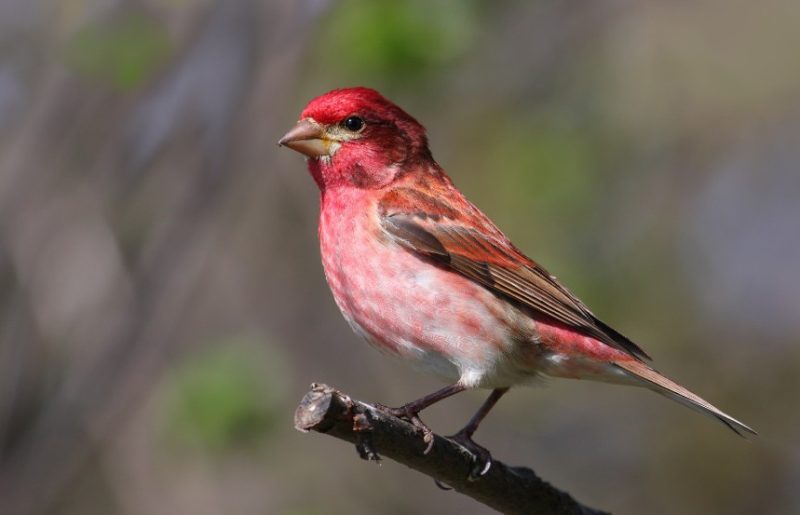
The Purple Finch (Haemorhous purpureus) is a vibrant bird known for its dark red head, pinkish back, and a mix of pink and white on its belly. The coloration of males often leads to confusion with the House Finch, though Purple Finches have a more saturated red hue.
Females have a more subdued appearance, with brown heads and brown-and-white streaked bodies. Unlike males, they lack any red coloring, making them easy to differentiate.
Found across North America, Purple Finches are most abundant in Canada, the northeastern United States, and parts of the eastern U.S. Some populations migrate south for the winter, especially those in Canada, while others remain year-round residents.
Their preference for high-altitude habitats and coniferous forests makes them well-suited for northern climates. However, their numbers are declining in some areas due to competition with the more aggressive House Finch.
Pileated Woodpecker
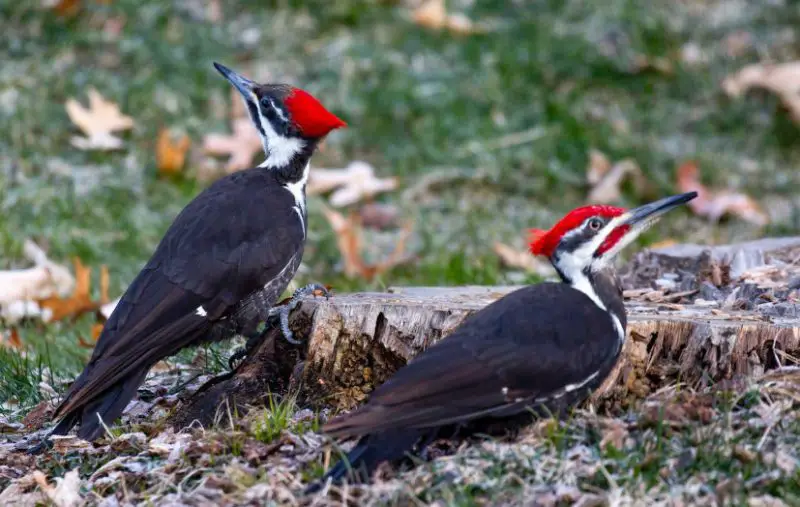
The Pileated Woodpecker (Dryocopus pileatus) is one of the largest woodpeckers in North America, growing up to 19 inches in length. Its striking appearance includes a red crest, black body, and white facial markings. The wings are mostly black with white patches visible in flight.
This species is commonly found in both large and small woodlands across Canada and the United States, inhabiting forests along the Atlantic and Pacific coasts. Pileated Woodpeckers are often seen in parks and even backyards with old trees.
A significant part of their diet consists of insects, particularly carpenter ants, which they extract from tree trunks using their strong beaks. Unlike many birds, the Pileated Woodpecker is non-migratory and remains active year-round.
House Finch
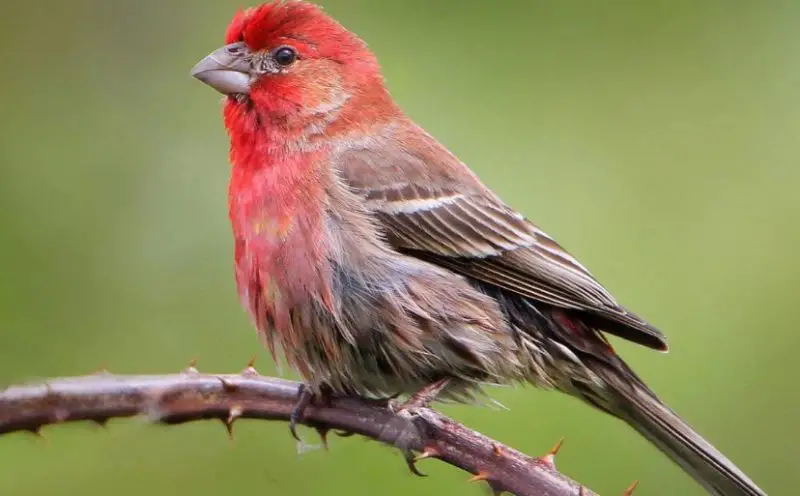
The House Finch (Haemorhous mexicanus) is a small songbird known for its bright red head, which is specific to most males. This red coloration extends down to the shoulders and upper chest, while some males only have red on the upper head. Females, on the other hand, lack red entirely and are covered in shades of gray and brown. Males have streaked chests and dark brown tails, whereas females display lighter gray and brown plumage. These birds vary in size, with some growing up to 6 inches long.
Native to Mexico and introduced to the United States, House Finches thrive in a variety of habitats, including parks, gardens, woodlands, and even urban areas. Their adaptability allows them to nest in human-made structures as well as natural environments. They are social birds often seen in flocks, feeding on seeds, berries, and small insects. Today, they are widespread across North America, making them one of the most common backyard birds.
Summer Tanager
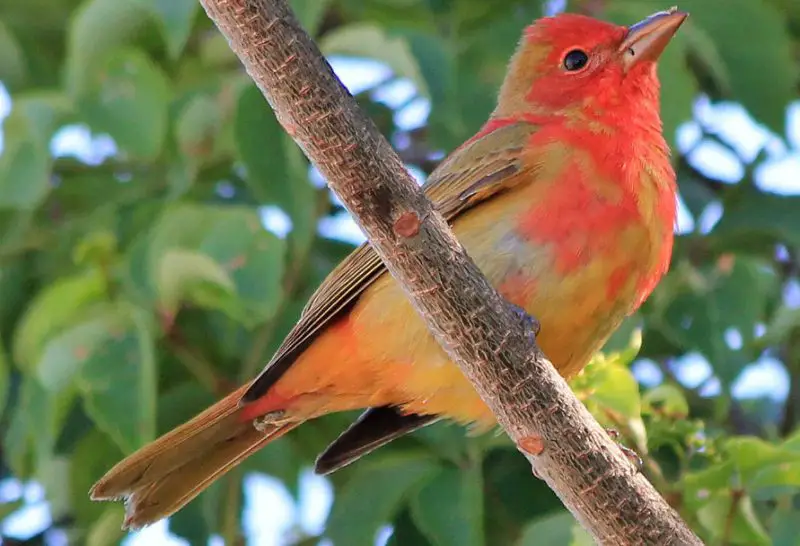
The Summer Tanager (Piranga rubra) is a striking bird known for its distinct coloration differences between males and females. Males are entirely red, including their heads, bodies, and wings, while females exhibit orange, olive-orange, or yellowish hues. The female’s chest and belly are brighter, with darker olive tones on the head and wings. One key characteristic of the male Summer Tanager is its bright, almost white beak, which helps distinguish it from other red birds. Additionally, its red shade is more of a rosy-red rather than a deep crimson. Some males may also have subtle olive outer wing feathers.
These birds inhabit forests, open woodlands, and riverbanks across North and Central America. They migrate between North America, where they breed, and Central and South America for the winter. Preferring tall trees, they are often found foraging for insects, especially bees and wasps, which they catch in mid-air. Their melodious song makes them easy to identify during the breeding season.
Red-headed Woodpecker
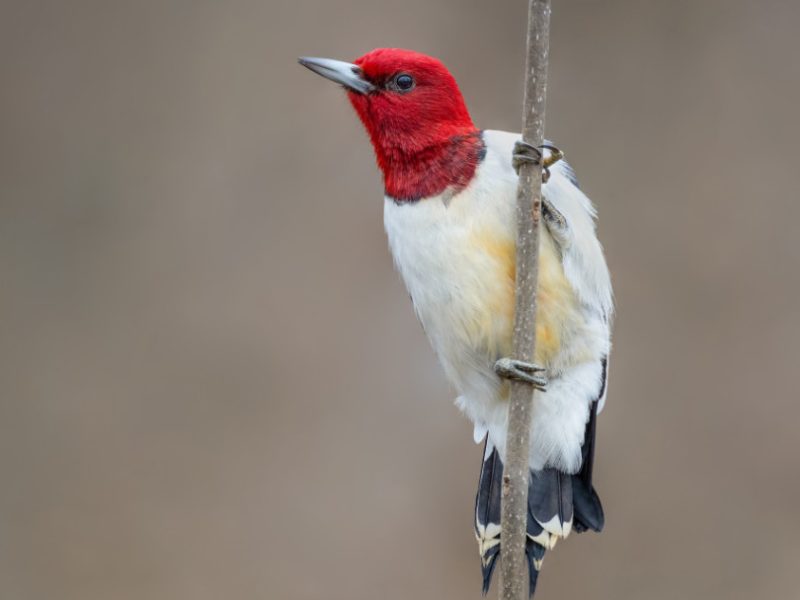
The Red-headed Woodpecker (Melanerpes erythrocephalus) is one of the few woodpecker species where both males and females share similar plumage. They have entirely red heads, along with white chests and bellies, while their backs and wings are black with white patches. Juveniles differ in appearance, having gray heads instead of red. These woodpeckers are easily distinguishable from the similar Red-bellied Woodpecker, which has red markings on its belly in addition to its head.
Red-headed Woodpeckers are found in the eastern United States and parts of southern Canada, inhabiting open woodlands, orchards, and wetlands. They are highly adaptable and known for their unique behavior of storing food, particularly acorns and insects, in tree crevices. As omnivores, they consume a varied diet that includes insects, seeds, fruits, and even small vertebrates. Unlike many other woodpecker species, they are adept at catching insects in flight.
Northern Cardinal
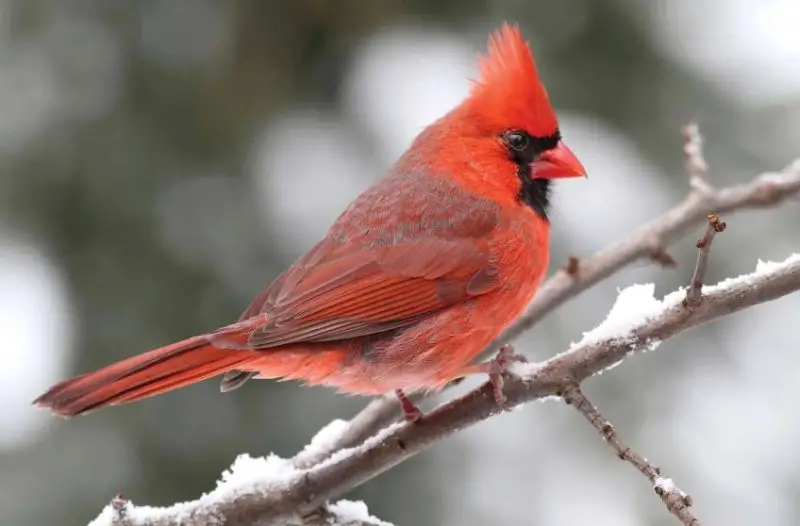
The Northern Cardinal (Cardinalis cardinalis) is one of North America’s most recognizable birds due to the male’s vibrant red plumage. Males have fully red bodies, including a striking red crest, while females are mostly grayish-brown with red tinges on the crest, wings, and tail. Both sexes share a distinctive black mask around their beak, adding to their unique appearance. Their red coloration is exceptionally bright, making them stand out among other birds with similar hues.
These birds are widespread across the eastern United States, eastern Mexico, and parts of Baja California. They are commonly found in woodlands, gardens, and urban areas, where they are known for their strong territorial behavior. Males use their loud, melodic songs to defend their territory and ward off rivals. Cardinals primarily feed on seeds, fruits, and insects, often visiting backyard feeders. Their adaptability and striking beauty make them a favorite among birdwatchers.
Vermilion Flycatcher
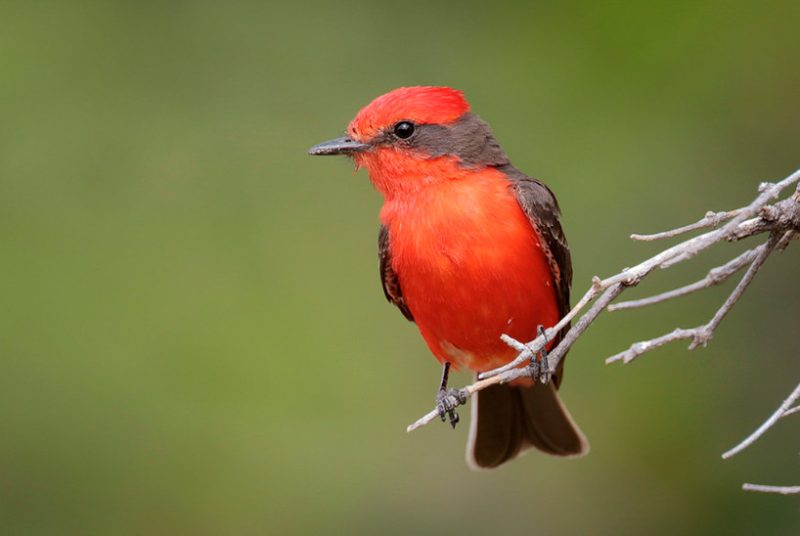
The Vermilion Flycatcher (Pyrocephalus rubinus) is a small yet striking bird known for its brilliant red plumage. Males have bright red heads, chests, and bellies, contrasted by brownish-gray wings with white streaks. Females, however, have brownish bodies with only a hint of red on their bellies, making them more difficult to distinguish from other brown birds. One unique behavior of female Vermilion Flycatchers is their tendency to lay eggs in the nests of other bird species.
These birds are commonly found in the southern United States, Mexico, and parts of Central and South America, including Colombia and Peru. They thrive in open areas, such as deserts, grasslands, and riverbanks, where they hunt insects in mid-air. Their name comes from their remarkable aerial hunting skills, as they often dart out from perches to snatch flying insects. Their bright colors and agile movements make them a fascinating sight in their natural habitat.
Acorn Woodpecker
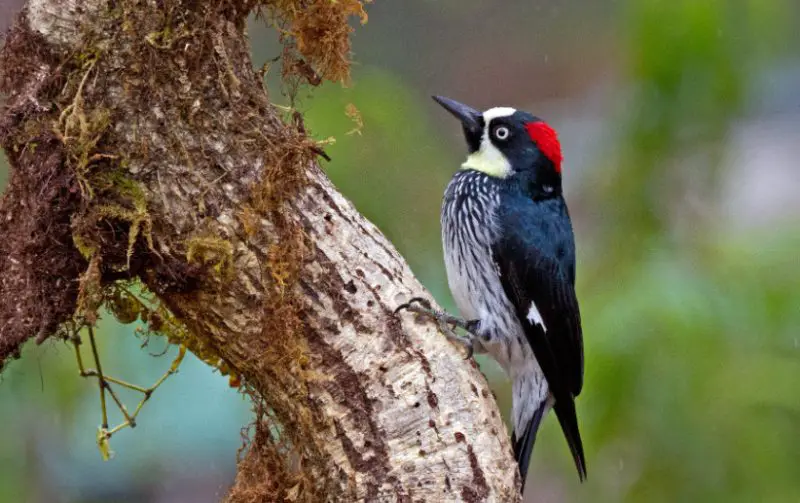
The Acorn Woodpecker (Melanerpes formicivorus) is a highly social bird known for its striking black-and-white facial markings and bright red crown. Both males and females share this vibrant red head, which contrasts sharply with their white face and black body.
As its name suggests, this species has a strong dependency on acorns, which it stores in tree cavities for future use. Acorn Woodpeckers are native to California and parts of Central America, including Mexico, Nicaragua, and Panama.
Their nesting behavior is unique, as they often form cooperative breeding groups where multiple males and a single female share parenting duties. These woodpeckers can be found in oak woodlands, where they drill holes into tree trunks to create storage spaces for their acorns.
Ladder-backed Woodpecker
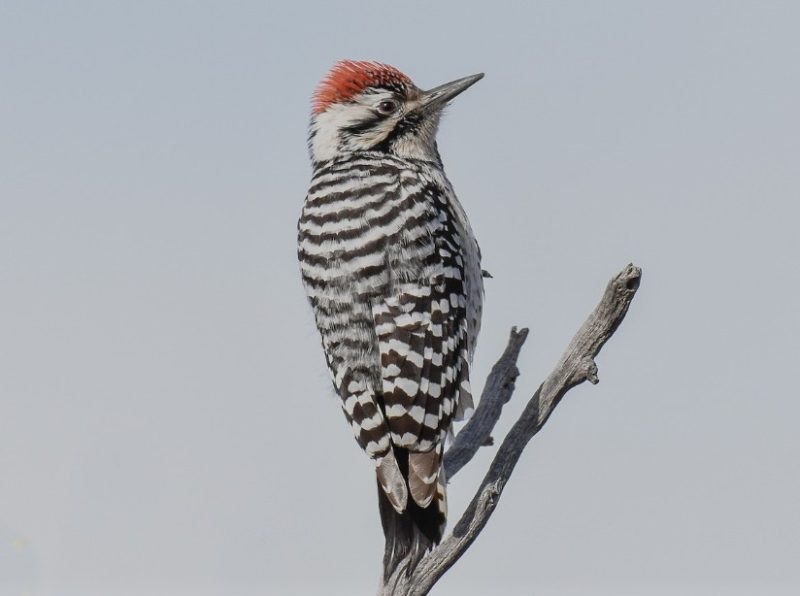
The Ladder-backed Woodpecker (Dryobates scalaris) is a small woodpecker with a distinctive red crown, present only in males. Its body is adorned with black-and-white striped patterns that resemble a ladder, giving the species its name.
Unlike many woodpeckers that prefer dense forests, the Ladder-backed Woodpecker thrives in arid environments such as deserts and dry woodlands. It is commonly seen in Texas, Arizona, and Mexico, often perched on cacti in search of insects.
This species primarily feeds on insects, but it also consumes fruit and occasionally catches flying insects. Females lay up to seven eggs in tree cavities, ensuring the next generation of this resilient bird.
Red-bellied Woodpecker
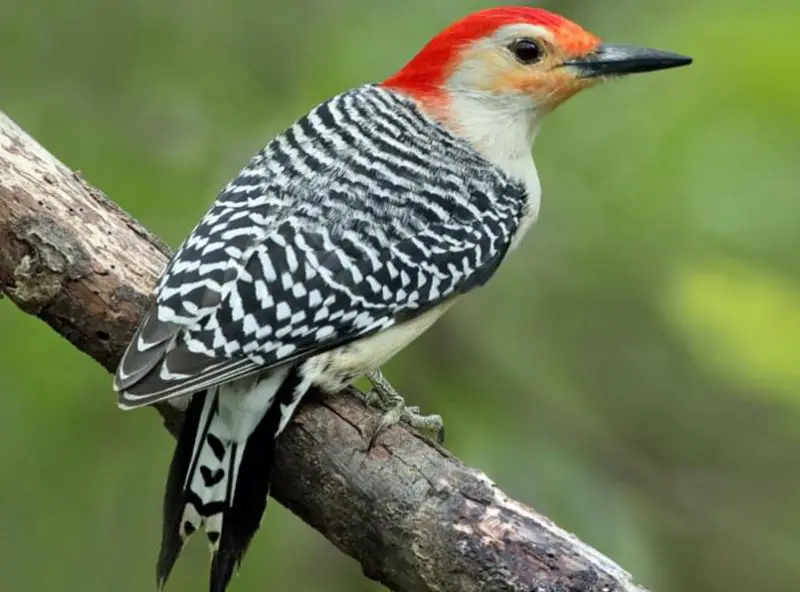
The Red-bellied Woodpecker (Melanerpes carolinus) is a medium-sized woodpecker native to the eastern United States. Despite its name, the red patch on its belly is often faint, while the most noticeable red marking is on its head.
Males have a red crown extending from the forehead to the nape, while females only have red on the back of their head. The rest of their body is covered in black-and-white barred patterns on the wings, with a pale grayish-white underside.
Red-bellied Woodpeckers are highly adaptable and can be found in forests, parks, and even suburban areas. Their diet consists of insects, fruits, and seeds. They are non-migratory and can be spotted throughout the year in their range.
Red-faced Warbler
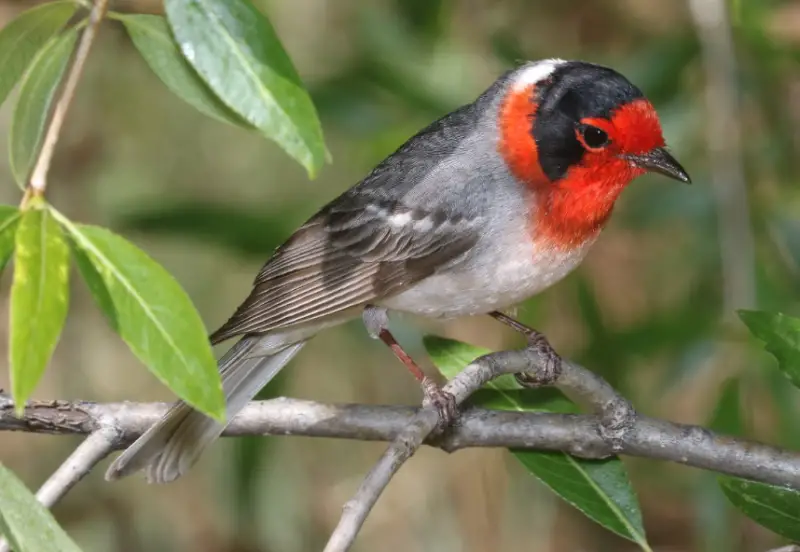
The Red-faced Warbler (Cardellina rubrifrons) is a small, brightly colored bird known for its distinctive red face and throat. The top back portion of its head is black, contrasting with its gray belly and dark wings, which may feature white wing bars.
This species inhabits mixed woodlands and shrublands in Central America, particularly in Mexico, Guatemala, Panama, and Colombia. While some populations migrate, especially those in northern Mexico, others remain in their habitats year-round.
Red-faced Warblers prefer building their nests on the ground, often in dense vegetation, where they remain well-camouflaged from predators. These birds are more commonly observed during the breeding season when their vivid red coloration makes them stand out among the foliage.
Red Crossbill
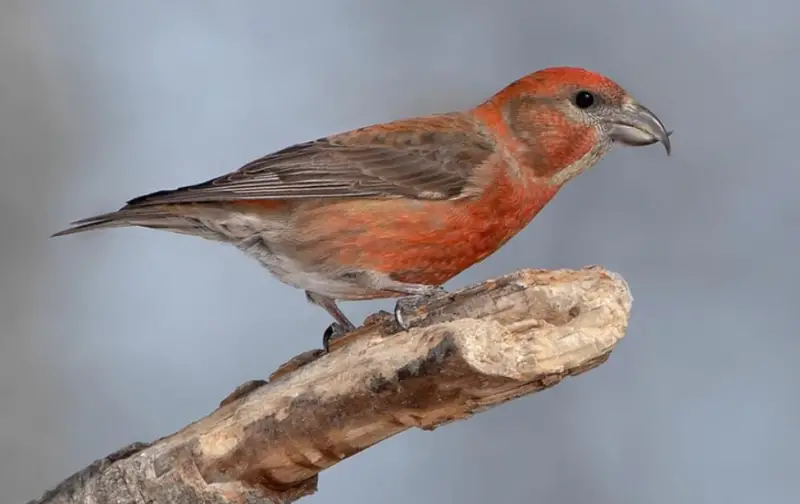
The Red Crossbill (Loxia curvirostra) is a unique finch species known for its crossed mandibles, an evolutionary adaptation that helps it extract seeds from conifer cones.
Male Red Crossbills display a mix of red and yellow on their head, body, and wings, while females are mostly yellow-brown with dark wings. The color variations within this species are influenced by geography, leading to differences in appearance across different regions.
Red Crossbills are widespread across the Northern Hemisphere, including North America, Europe, and parts of Asia. They are often found in coniferous forests, where their specialized beaks allow them to thrive. Their distinctive calls and songs can frequently be heard echoing through woodlands.
Yellow-bellied Sapsucker
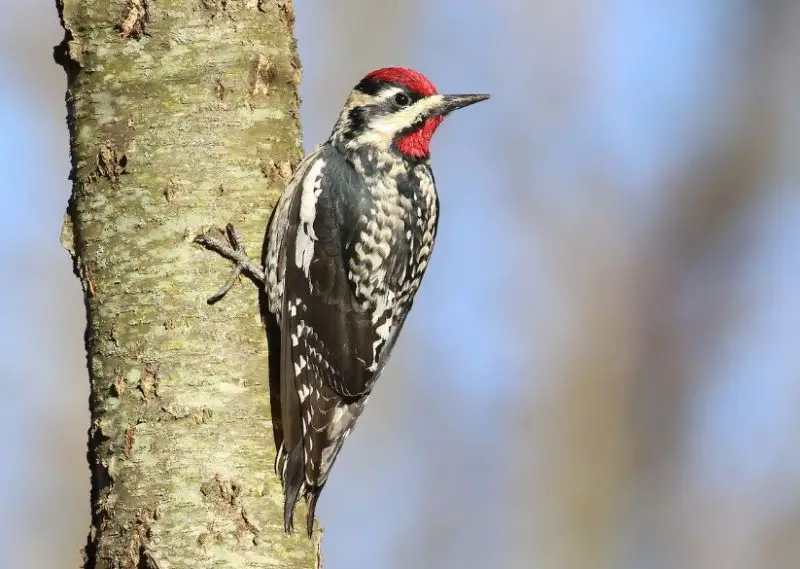
The Yellow-bellied Sapsucker (Sphyrapicus varius) is a striking woodpecker with a red forehead, black-and-white patterned body, and a pale yellow belly. Males also have a red throat, while females have a white throat.
This species is native to North America and is commonly found in forests dominated by aspen, maple, and birch trees. Unlike other woodpeckers, the Yellow-bellied Sapsucker feeds not only on insects but also on tree sap. It drills neat rows of holes into tree bark to access the sap, which also attracts insects—another food source for the bird.
Although primarily solitary, this species occasionally feeds in groups, which can cause significant damage to trees. Yellow-bellied Sapsuckers migrate, spending summers in Canada and the northern United States before traveling south to overwinter in the U.S., Mexico, and the West Indies.
Red-naped Sapsucker
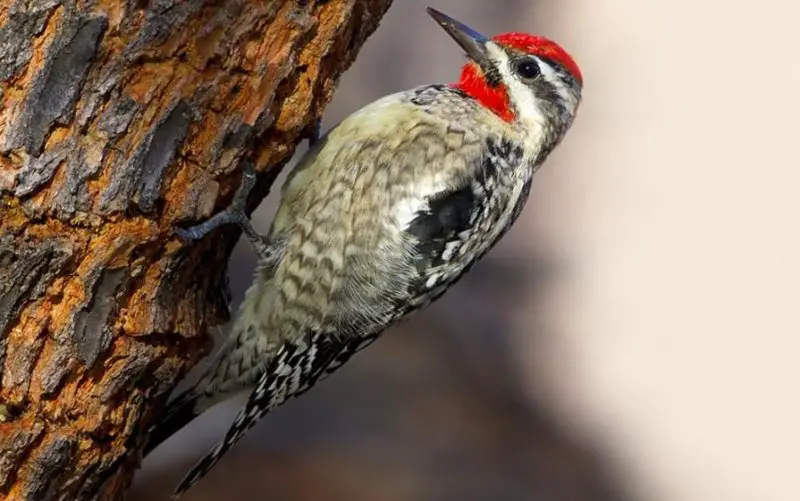
The Red-naped Sapsucker (Sphyrapicus nuchalis) is a medium-sized woodpecker that features a red cap, red throat, and black-and-white streaked body. Its wings have bold black-and-white markings, and its belly is pale with hints of yellow.
Found in the western and southwestern United States, this species inhabits forests with willow and aspen trees. Like other sapsuckers, it drills holes into tree trunks to consume sap, which also attracts insects. By feeding on these insects, the Red-naped Sapsucker plays an important role in forest ecosystems.
During the breeding season, it may hybridize with other sapsucker species, creating individuals with mixed plumage patterns. These birds are migratory, spending their breeding months in higher elevations and moving to lower regions during the winter.
Lineated Woodpecker
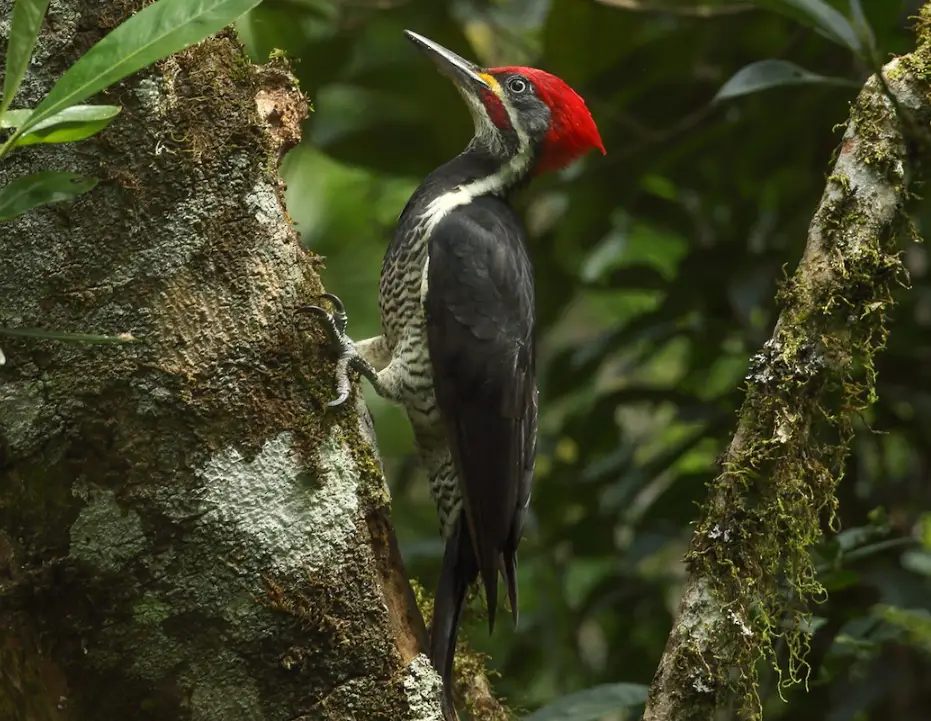
The Lineated Woodpecker (Dryocopus lineatus) is a striking woodpecker species with a bold red crest and contrasting black-and-white plumage. Its head features red, black, and yellow markings, while its body is mostly black with a distinctive white stripe running from its head to its tail.
This species inhabits coniferous and mixed woodlands, where it primarily feeds on insects, fruits, and caterpillars. Known for its loud, rhythmic drumming, the Lineated Woodpecker is commonly found across a vast range extending from Mexico to Argentina.
Black Woodpecker
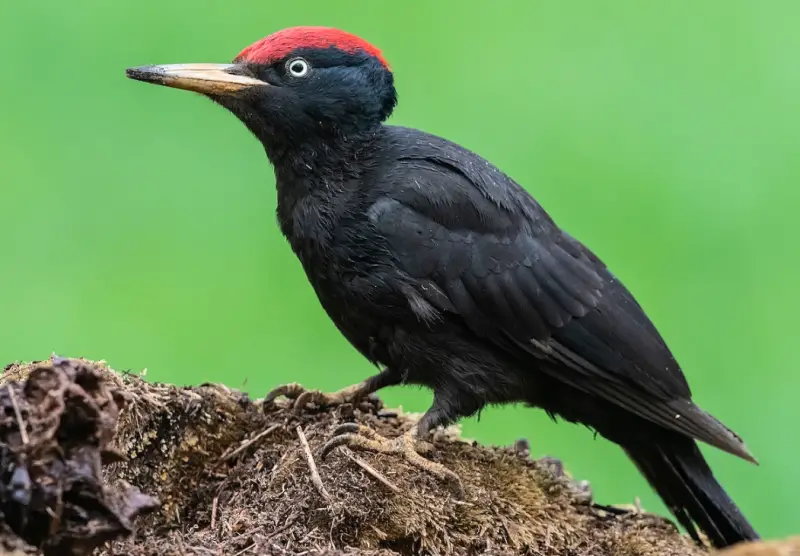
The Black Woodpecker (Dryocopus martius) is one of the largest woodpecker species, often exceeding 30 inches in length. It has an all-black body, with a bright red crown on its head. Males have a fully red crest, while females have a smaller red patch.
This species is found across Europe and Asia, residing in old-growth forests where it excavates large tree cavities for nesting. Due to deforestation, Black Woodpecker populations have declined in some areas, but they remain widely distributed across Russia, China, and parts of Europe.
Red-capped Cardinal
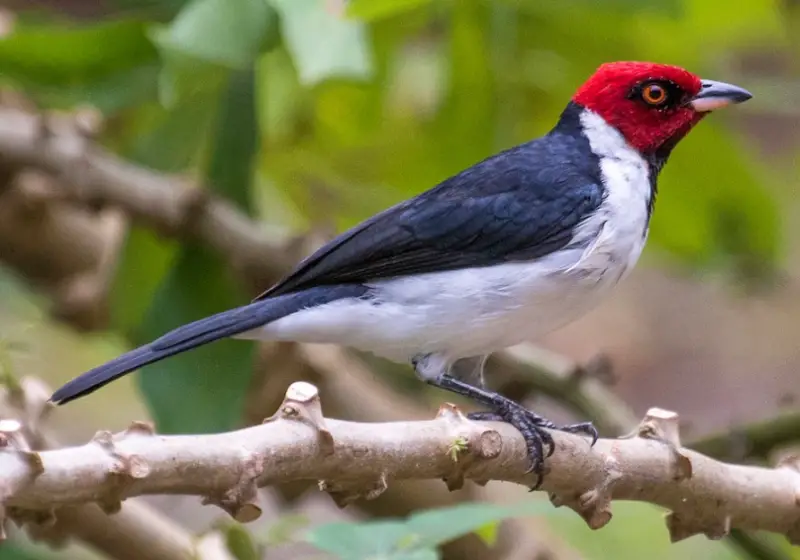
The Red-capped Cardinal (Paroaria gularis) is a South American bird known for its vibrant red head and black-and-white body. It has a black face mask, a white belly, and black wings. Its beak is uniquely two-toned, with a black upper mandible and a yellow lower mandible.
This species thrives in low-elevation woodlands, where it feeds on fruits, seeds, and rice crops. Unlike its northern relatives, the Red-capped Cardinal is exclusive to Central and South America, with populations found in Brazil, Colombia, Ecuador, and Bolivia.
Gang-gang Cockatoo
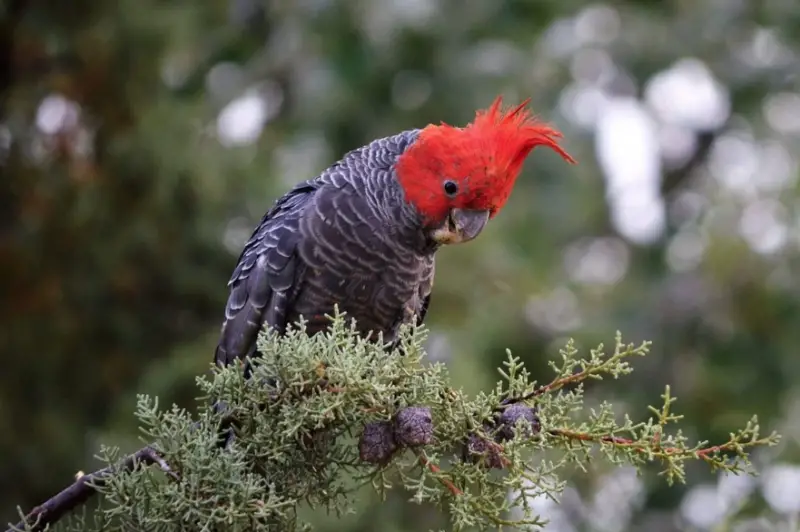
The Gang-gang Cockatoo (Callocephalon fimbriatum) is a distinctive parrot species endemic to southeastern Australia. Males have a striking red head and crest, while females are entirely gray.
These cockatoos inhabit forested areas and feed on a variety of fruits, seeds, and peppercorns. They are known for their unique, creaky call, resembling the sound of a rusty door hinge. Gang-gang Cockatoos migrate short distances between open woodlands and dense forests depending on the breeding season.
Eastern Rosella
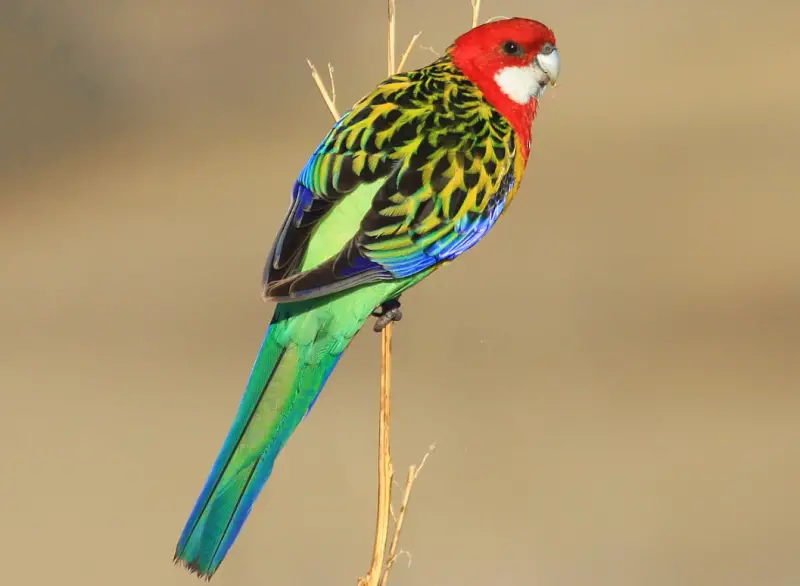
The Eastern Rosella (Platycercus eximius) is a brilliantly colored parrot native to Australia and parts of New Zealand. Both males and females sport red heads, red necks, and multicolored plumage, including yellow, green, black, and blue.
These birds are commonly found in open woodlands, gardens, and farmlands, where they feed on seeds, fruits, and flowers. Various subspecies of the Eastern Rosella exist across Oceania, each exhibiting slight variations in coloration.
Australian King-Parrot
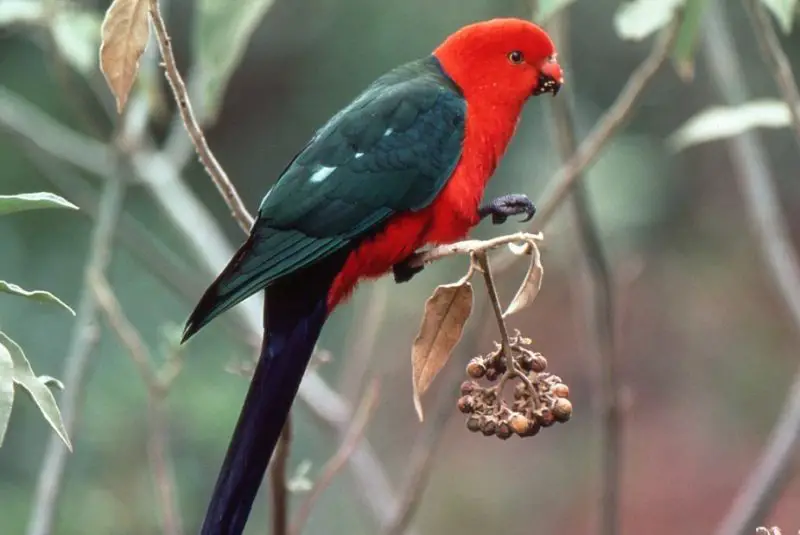
The Australian King-Parrot (Alisterus scapularis) is a striking parrot species known for its vivid red head, red chest, and red belly. Males have dark green wings, while females have a green head and darker green plumage overall.
Juvenile Australian King-Parrots resemble females but display brighter green heads and red lower bellies. These birds are native to eastern Australia, often seen in rainforests and woodlands. While they can be kept as pets, they are not as easily handled as some other parrot species.
Red-cowled Cardinal
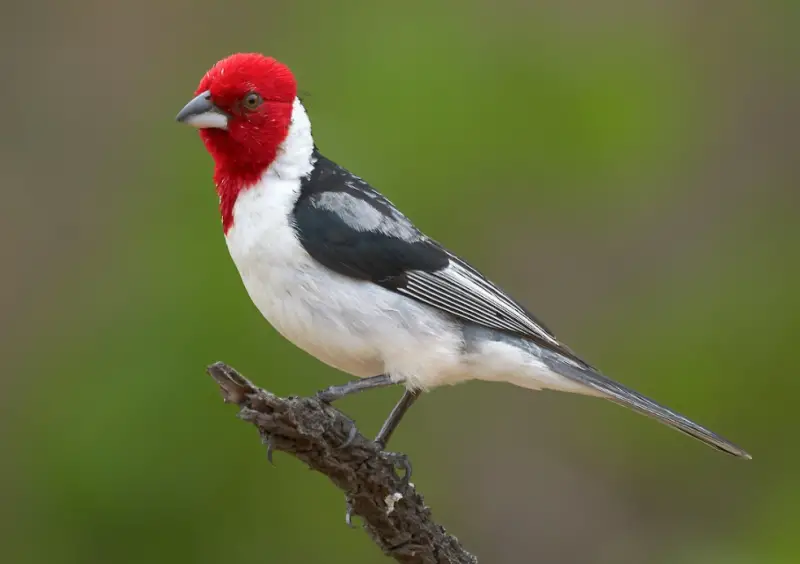
Red-cowled Cardinal (Paroaria dominicana) is a striking bird species native to Eastern Brazil, recognized for its vivid red head and contrasting white and black body. Males have a bright red head, a gray and white beak, a white belly, and black-and-white wings. In contrast, females display a yellowish head and an off-white or bright yellow belly. Juveniles resemble females but may have an orange, white, or tan head.
These birds thrive in semi-open habitats such as dry forests, scrublands, and urban parks. They primarily feed on seeds and insects, making them a common sight in areas with abundant vegetation. Their adaptability to different environments allows them to flourish even in human-populated regions.
Common Rosefinch
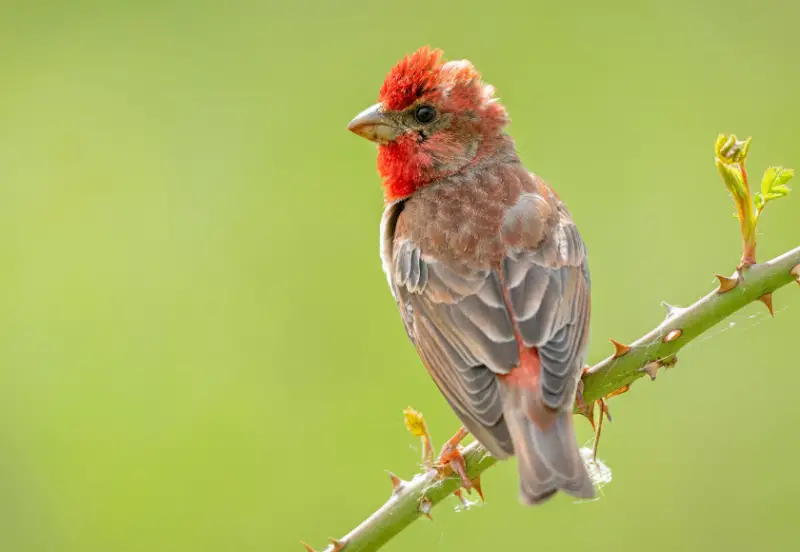
Common Rosefinch (Carpodacus erythrinus) is a small yet colorful finch species distributed across Europe and Asia. Males have a deep red head, extending to the upper chest, with a gradual transition to pink and white on the lower belly. Their wings and back are brownish, providing a striking contrast to their bright red plumage. Females and juveniles lack the red coloration, displaying brown, yellow-brown, or golden-brown feathers instead.
This species prefers forest edges, shrublands, and riverbanks, where it feeds on seeds, buds, and berries. Some populations, particularly those in Southern Asia, migrate seasonally for breeding, moving to higher altitudes during the summer months. Their melodious song makes them easy to identify in their natural habitat.
Masked Cardinal
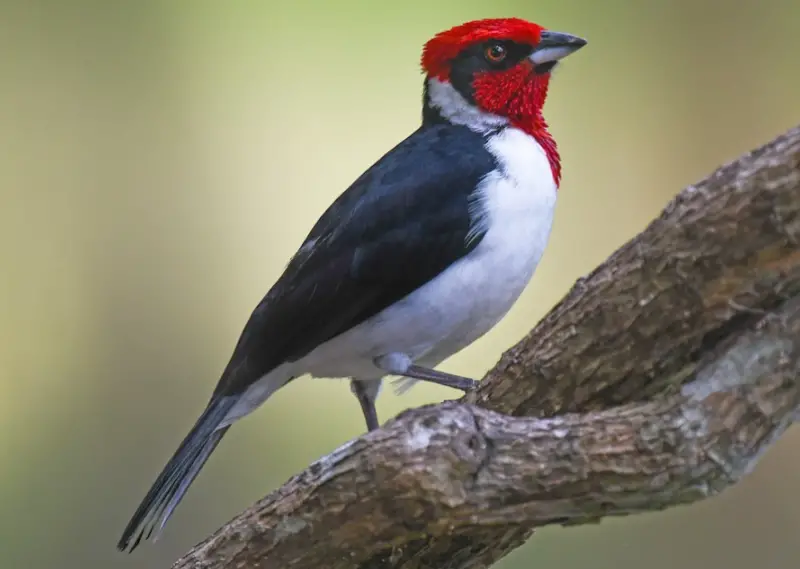
Masked Cardinal (Paroaria nigrogenis) is a distinctive bird found in Venezuela, Colombia, and Trinidad and Tobago. It is characterized by its dark red head, which contrasts sharply with a black “mask” around the eyes. The bird’s chest and belly are pure white, while its wings are black. Its beak is typically bicolored, with a black upper mandible and a paler lower mandible.
These birds are commonly found in wetlands, mangroves, and riverbanks, often foraging for insects and seeds. Their striking appearance and adaptability to different environments make them a popular species among birdwatchers in their native range. They are also sometimes kept as pets due to their attractive colors and lively nature.
Southern Red Bishop
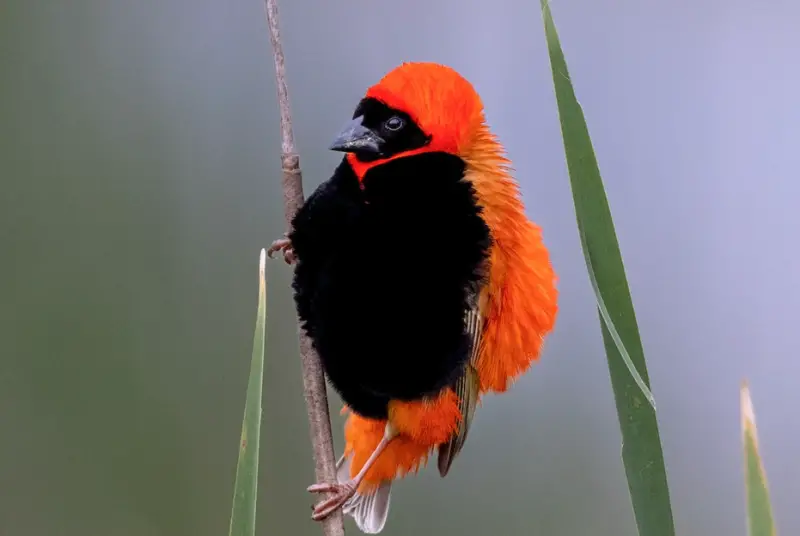
Southern Red Bishop (Euplectes orix) is a small but vibrant bird native to sub-Saharan Africa, particularly in Uganda, Congo, Angola, and South Africa. Males of the species are known for their brilliant red heads and upper chests, which contrast with a black face mask and black belly. The rest of the body is also predominantly red, making them highly visible in grasslands and wetland areas.
Females, on the other hand, have a more subdued appearance, with a tan or gray body and a dark brown head. This species primarily feeds on seeds and is often spotted near water sources, especially during the breeding season. Males display elaborate courtship behaviors, such as puffing up their feathers and making short, jerky flights to attract mates.
Vermilion Flycatcher

Vermilion Flycatcher (Pyrocephalus rubinus) is a stunning bird found across North, Central, and South America, including regions such as Arizona, Texas, Mexico, Ecuador, and Colombia. Males of the species have a bright red head and crest, along with a red belly and brown wings. Females, in contrast, lack the crest and red head, instead having a brownish head, grayish upper chest, and a reddish-orange lower belly.
This flycatcher is an agile hunter, often perching on low branches before darting out to catch insects mid-air. Interestingly, Vermilion Flycatchers are known for their brood parasitic behavior within their species, occasionally laying eggs in the nests of other Vermilion Flycatchers. Their striking colors and unique behaviors make them a favorite among bird enthusiasts.


